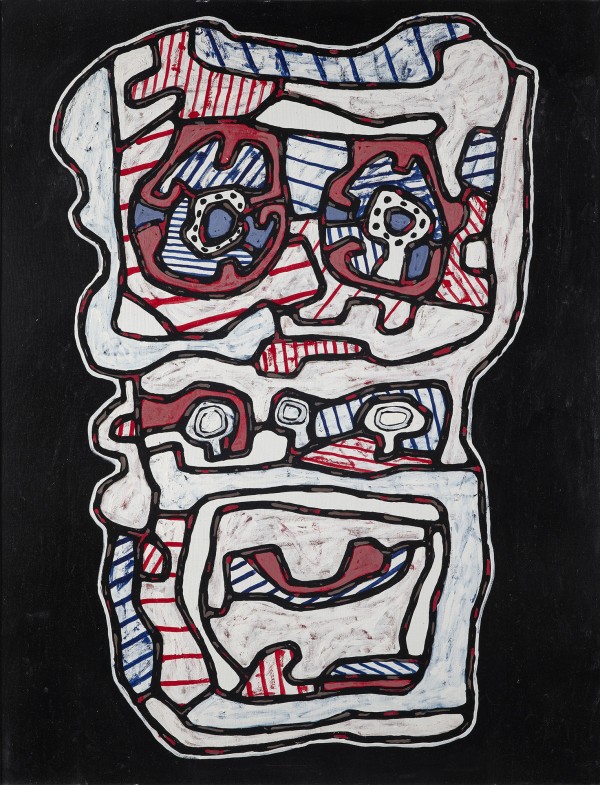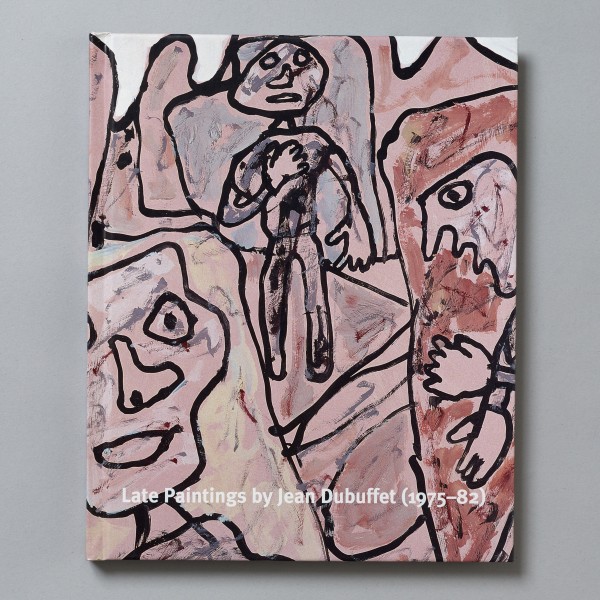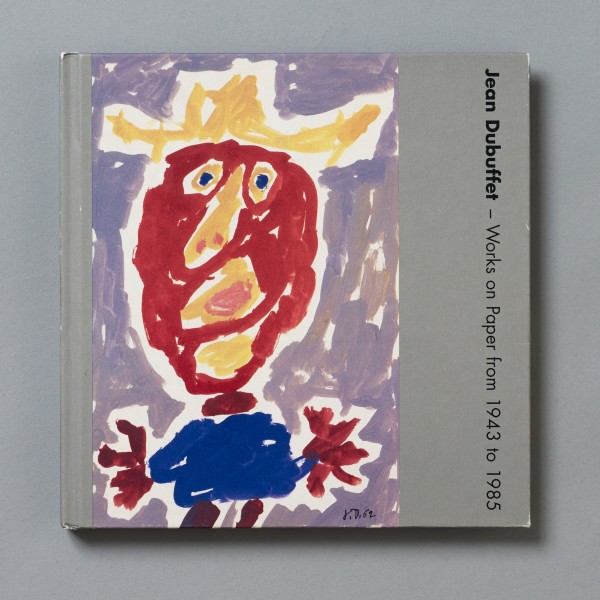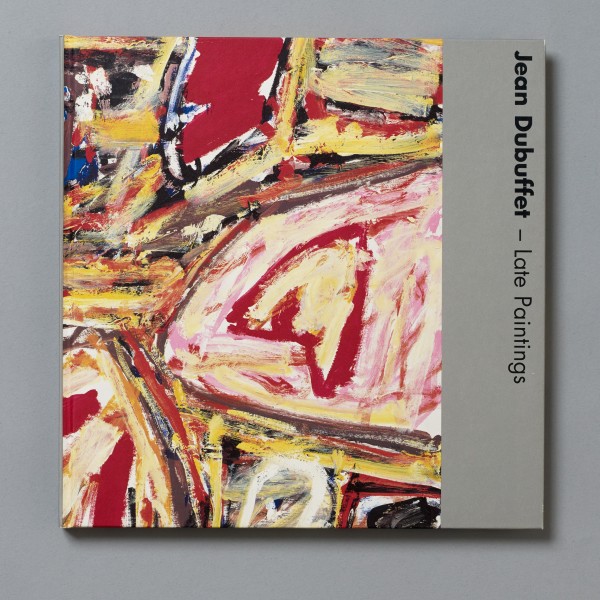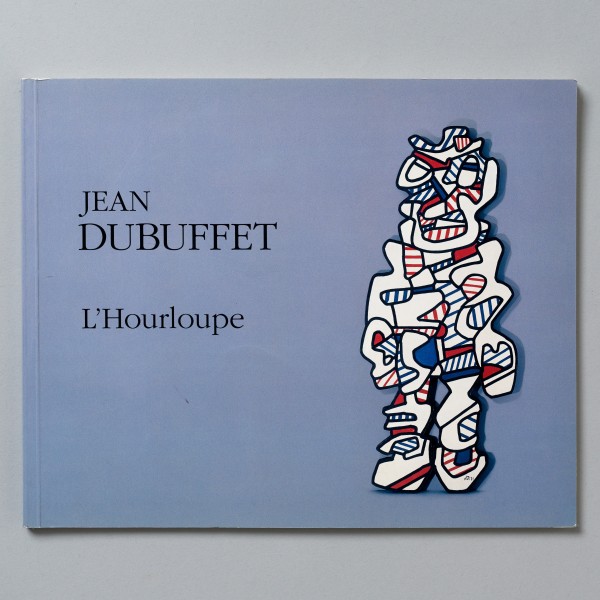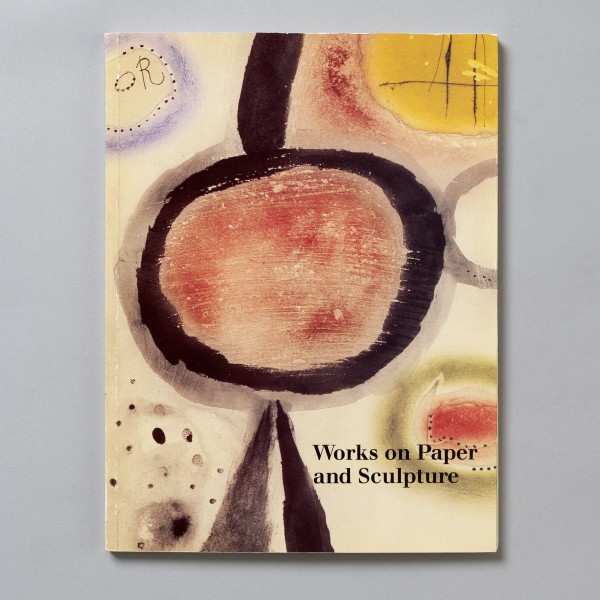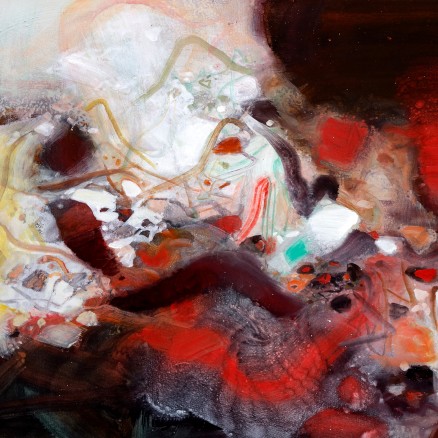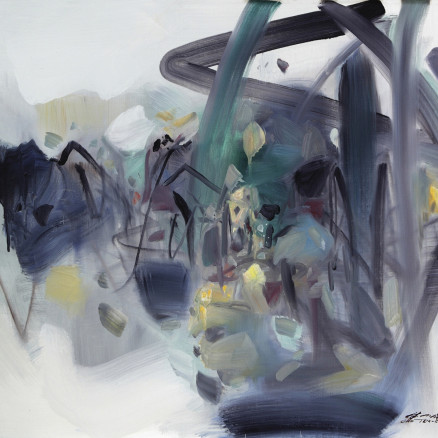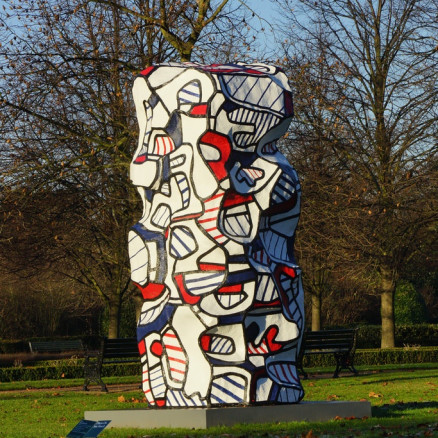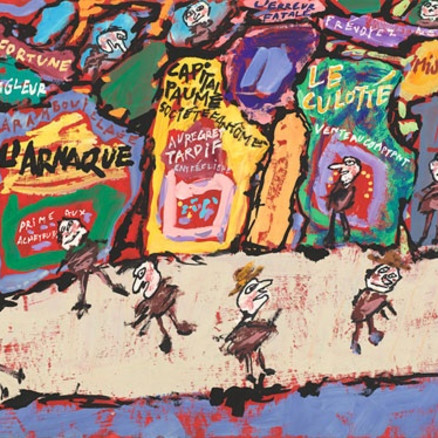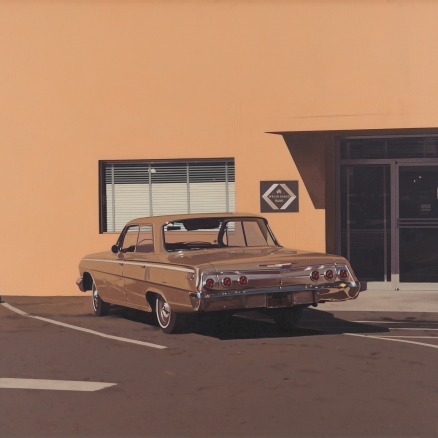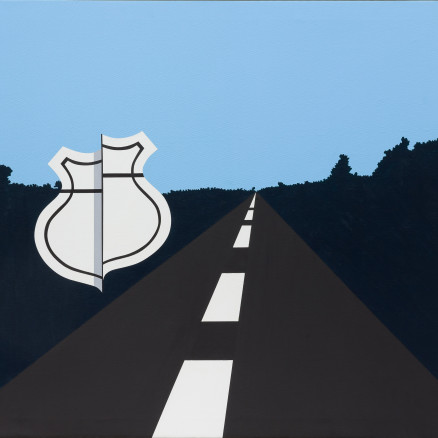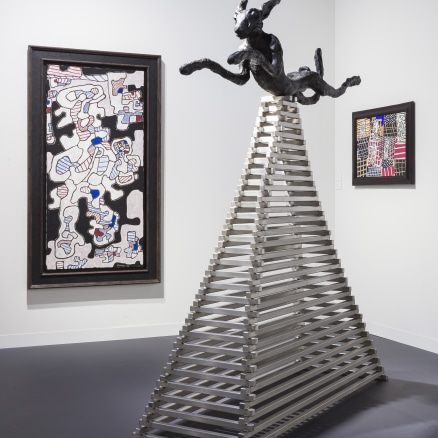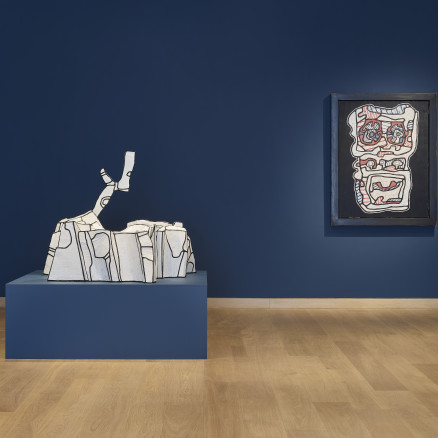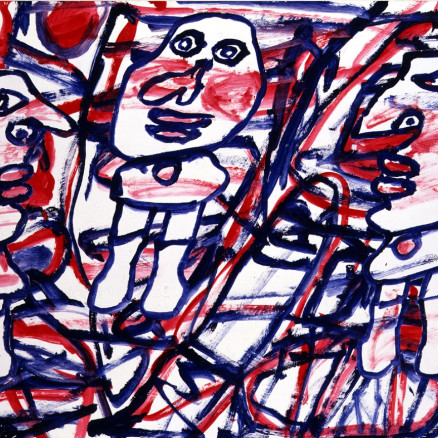Biography
Jean Dubuffet (b. 1901, Le Havre, France; d. 1985, Paris, France) is widely recognized as the most innovative artist in post-war France. A pioneer of outsider art, or ‘art brut’, Dubuffet sought to redefine aesthetic norms by drawing on the art of children, iconoclasts and the insane. In his view, because mainstream culture would systematically appropriate and sterilise artistic developments, authentic art could only be created spontaneously, without concern for any audience. On the premise that art takes its language from the materials used, Dubuffet scratched, kneaded and painted on resin, before applying plaster, sand, tar and other elements with a palette knife. In later years, he created monumental sculptures, installations and collages.
Dubuffet moved to Paris in 1918 where he briefly studied art at the Académie Julian. In 1925, he began working in the wine trade but painted periodically until 1942, after which he devoted himself exclusively to painting. In 1948 he created the Compagnie de l’Art Brut, along with the André Breton and the critic Michel Tapié. His first solo exhibition was in 1944 at the Gallery René Drouin in Paris. His first solo exhibition in New York was held at the Pierre Matisse Gallery (1947). During his lifetime, major exhibitions of his work included: Musée des Arts Décoratifs, Paris (1960–61), Museum of Modern Art, New York (1962), Tate Gallery, London (1966), Guggenheim Museum, New York (1973) and Akademie der Künst, Berlin (1980).
Since his death in 1985, Dubuffet’s work has continued to be exhibited worldwide. Major retrospectives have been held at Galerie nationale du Jeu de Paume, Paris (1991), Hirshhorn Museum and Sculpture Garden, Washington DC (1993), Saarland Museum, Saarbrücken, Germany (1999) and a centenary exhibition at the Centre Georges-Pompidou in Paris (2001).
Read more
Works
-
 Jean Dubuffet, Site aléatoire avec 2 personnages 29 mars 1982, 1982
acrylic on paper on canvas
26 3/8 x 39 3/8 in
67 x 100 cm
%3Cdiv%20class%3D%22artist%22%3E%3Cspan%20class%3D%22artist%22%3E%3Cstrong%3EJean%20Dubuffet%3C%2Fstrong%3E%3C%2Fspan%3E%3C%2Fdiv%3E%0D%3Cdiv%20class%3D%22title%22%3E%3Cem%3ESite%20al%C3%A9atoire%20avec%202%20personnages%2029%20mars%201982%3C%2Fem%3E%2C%201982%3C%2Fdiv%3E%0D%3Cdiv%20class%3D%22medium%22%3Eacrylic%20on%20paper%20on%20canvas%3Cbr%20%2F%3E%0A%3C%2Fdiv%3E%0D%3Cdiv%20class%3D%22dimensions%22%3E26%203%2F8%20x%2039%203%2F8%20in%3Cbr%20%2F%3E%0A67%20x%20100%20cm%3C%2Fdiv%3E
Jean Dubuffet, Site aléatoire avec 2 personnages 29 mars 1982, 1982
acrylic on paper on canvas
26 3/8 x 39 3/8 in
67 x 100 cm
%3Cdiv%20class%3D%22artist%22%3E%3Cspan%20class%3D%22artist%22%3E%3Cstrong%3EJean%20Dubuffet%3C%2Fstrong%3E%3C%2Fspan%3E%3C%2Fdiv%3E%0D%3Cdiv%20class%3D%22title%22%3E%3Cem%3ESite%20al%C3%A9atoire%20avec%202%20personnages%2029%20mars%201982%3C%2Fem%3E%2C%201982%3C%2Fdiv%3E%0D%3Cdiv%20class%3D%22medium%22%3Eacrylic%20on%20paper%20on%20canvas%3Cbr%20%2F%3E%0A%3C%2Fdiv%3E%0D%3Cdiv%20class%3D%22dimensions%22%3E26%203%2F8%20x%2039%203%2F8%20in%3Cbr%20%2F%3E%0A67%20x%20100%20cm%3C%2Fdiv%3E -
 Jean Dubuffet, Voie piétonnière 20 janvier 1981, 1981
Acrylic on canvas
39 x 31 3/4 in
100 x 81 cm
%3Cdiv%20class%3D%22artist%22%3E%3Cspan%20class%3D%22artist%22%3E%3Cstrong%3EJean%20Dubuffet%3C%2Fstrong%3E%3C%2Fspan%3E%3C%2Fdiv%3E%0D%3Cdiv%20class%3D%22title%22%3E%3Cem%3EVoie%20pi%C3%A9tonni%C3%A8re%2020%20janvier%201981%3C%2Fem%3E%2C%201981%3C%2Fdiv%3E%0D%3Cdiv%20class%3D%22medium%22%3EAcrylic%20on%20canvas%3Cbr%20%2F%3E%0A%3C%2Fdiv%3E%0D%3Cdiv%20class%3D%22dimensions%22%3E39%20x%2031%203%2F4%20in%3Cbr%20%2F%3E%0A100%20x%2081%20cm%3C%2Fdiv%3E
Jean Dubuffet, Voie piétonnière 20 janvier 1981, 1981
Acrylic on canvas
39 x 31 3/4 in
100 x 81 cm
%3Cdiv%20class%3D%22artist%22%3E%3Cspan%20class%3D%22artist%22%3E%3Cstrong%3EJean%20Dubuffet%3C%2Fstrong%3E%3C%2Fspan%3E%3C%2Fdiv%3E%0D%3Cdiv%20class%3D%22title%22%3E%3Cem%3EVoie%20pi%C3%A9tonni%C3%A8re%2020%20janvier%201981%3C%2Fem%3E%2C%201981%3C%2Fdiv%3E%0D%3Cdiv%20class%3D%22medium%22%3EAcrylic%20on%20canvas%3Cbr%20%2F%3E%0A%3C%2Fdiv%3E%0D%3Cdiv%20class%3D%22dimensions%22%3E39%20x%2031%203%2F4%20in%3Cbr%20%2F%3E%0A100%20x%2081%20cm%3C%2Fdiv%3E -
 Jean Dubuffet, L'heure de pointe 8 décembre 1980, 1980
acrylic on canvas
100 x 81 cm
%3Cdiv%20class%3D%22artist%22%3E%3Cspan%20class%3D%22artist%22%3E%3Cstrong%3EJean%20Dubuffet%3C%2Fstrong%3E%3C%2Fspan%3E%3C%2Fdiv%3E%0D%3Cdiv%20class%3D%22title%22%3E%3Cem%3EL%27heure%20de%20pointe%208%20d%C3%A9cembre%201980%3C%2Fem%3E%2C%201980%3C%2Fdiv%3E%0D%3Cdiv%20class%3D%22medium%22%3Eacrylic%20on%20canvas%3C%2Fdiv%3E%0D%3Cdiv%20class%3D%22dimensions%22%3E100%20x%2081%20cm%3C%2Fdiv%3E
Jean Dubuffet, L'heure de pointe 8 décembre 1980, 1980
acrylic on canvas
100 x 81 cm
%3Cdiv%20class%3D%22artist%22%3E%3Cspan%20class%3D%22artist%22%3E%3Cstrong%3EJean%20Dubuffet%3C%2Fstrong%3E%3C%2Fspan%3E%3C%2Fdiv%3E%0D%3Cdiv%20class%3D%22title%22%3E%3Cem%3EL%27heure%20de%20pointe%208%20d%C3%A9cembre%201980%3C%2Fem%3E%2C%201980%3C%2Fdiv%3E%0D%3Cdiv%20class%3D%22medium%22%3Eacrylic%20on%20canvas%3C%2Fdiv%3E%0D%3Cdiv%20class%3D%22dimensions%22%3E100%20x%2081%20cm%3C%2Fdiv%3E -
 Jean Dubuffet, Site aux itinéraires (T 121) 9 septembre 1975, 1975
acrylic on canvas
114 x 146 cm
Jean Dubuffet, Site aux itinéraires (T 121) 9 septembre 1975, 1975
acrylic on canvas
114 x 146 cm
-
 Jean Dubuffet, Welcome Parade (after maquette dated 2 July 1974), 1974-2008
polyurethane paint on epoxy resin 4,300 kg / 9460 lb
157 x 327 x 200 in / 398.8 x 830.6 x 508 cm
Jean Dubuffet, Welcome Parade (after maquette dated 2 July 1974), 1974-2008
polyurethane paint on epoxy resin 4,300 kg / 9460 lb
157 x 327 x 200 in / 398.8 x 830.6 x 508 cm
-
 Jean Dubuffet, Tour aux récits (after maquette dated 19 July 1973), 1973-2007
polyurethane paint on epoxy resin (sculpture 350/400 kg)
160 x 74 x 74 in / 406.4 x 188 x 188 cm
%3Cdiv%20class%3D%22artist%22%3E%3Cspan%20class%3D%22artist%22%3E%3Cstrong%3EJean%20Dubuffet%3C%2Fstrong%3E%3C%2Fspan%3E%3C%2Fdiv%3E%0D%3Cdiv%20class%3D%22title%22%3E%3Cem%3ETour%20aux%20r%C3%A9cits%20%28after%20maquette%20dated%2019%20July%201973%29%3C%2Fem%3E%2C%201973-2007%3C%2Fdiv%3E%0D%3Cdiv%20class%3D%22medium%22%3Epolyurethane%20paint%20on%20epoxy%20resin%20%28sculpture%20350%2F400%20kg%29%3C%2Fdiv%3E%0D%3Cdiv%20class%3D%22dimensions%22%3E160%20x%2074%20x%2074%20in%20%2F%20406.4%20x%20188%20x%20188%20cm%3C%2Fdiv%3E
Jean Dubuffet, Tour aux récits (after maquette dated 19 July 1973), 1973-2007
polyurethane paint on epoxy resin (sculpture 350/400 kg)
160 x 74 x 74 in / 406.4 x 188 x 188 cm
%3Cdiv%20class%3D%22artist%22%3E%3Cspan%20class%3D%22artist%22%3E%3Cstrong%3EJean%20Dubuffet%3C%2Fstrong%3E%3C%2Fspan%3E%3C%2Fdiv%3E%0D%3Cdiv%20class%3D%22title%22%3E%3Cem%3ETour%20aux%20r%C3%A9cits%20%28after%20maquette%20dated%2019%20July%201973%29%3C%2Fem%3E%2C%201973-2007%3C%2Fdiv%3E%0D%3Cdiv%20class%3D%22medium%22%3Epolyurethane%20paint%20on%20epoxy%20resin%20%28sculpture%20350%2F400%20kg%29%3C%2Fdiv%3E%0D%3Cdiv%20class%3D%22dimensions%22%3E160%20x%2074%20x%2074%20in%20%2F%20406.4%20x%20188%20x%20188%20cm%3C%2Fdiv%3E -
 Jean Dubuffet, Réchaud-four à gaz IV (Autoportrait) 12 mars 1966, 1966
vinyl paint on canvas
116 x 89 cm
Jean Dubuffet, Réchaud-four à gaz IV (Autoportrait) 12 mars 1966, 1966
vinyl paint on canvas
116 x 89 cm
Jean Dubuffet Tour aux récits
(after maquette dated 19 July 1973)
1973–2007
Installation at Smithson Plaza, from Sept 2020
Latest














